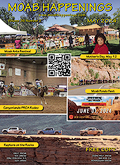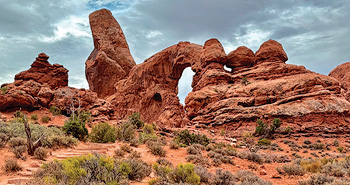
I love an overcast day, and we don’t get that many in Moab. So, on a windswept, cloudy fall morning I drove up to Arches for a gastronomic and geologic breakfast. After the Visitor Center, I drove 9.5 miles up the scenic byway, 0.3 miles past the turnoff to Balanced Rock, and went right/east toward the Windows Section. I then went an additional 2.5 miles around the loop to the parking area, which this morning was only half full. Several times I have walked to the South and North Windows plus hiked the Primitive Trail over the years, but, on this breezy morning, I chose to focus on the free-standing sandstone fin of Turret Arch.
My first stop was the restroom complex. My stall offered both American style and floor- mounted, “Turkish” squat-type toilet options, something I hadn’t seen since my old apartment building in Paris. My second stop was the boot-cleaning station to brush off any invasive seeds or soil my shoes might be carrying. A third stop was a flat-topped sandstone slab where I enjoyed my breakfast of a granola bar and grapes. Following the trail to the first junction, I went right/ south, as I planned to only visit Turret Arch. However, from Turret (and sometimes through its arch opening), you can view The Windows to the east, Elephant Butte to the north, and the La Sal Mountains to the southeast. At 35 feet wide and 65 feet tall, Turret Arch’s opening is the smallest of the arches accessed from Windows trails. But it’s not the opening that gives this arch its name; it’s the sidecar pillar. To my eye, the arch opening resembles the outline of South America or maybe the state of Illinois. Two small holes near the arch opening also share Turret’s formation.
In 1934, Frank Beckwith, a newspaper editor from Delta, Utah, took a crew of men and horses to map and explore the Windows area with his Arches National Monument Scientific Expedition.
Crew foreman Jack YouVon joked to Beckwith that he’d found a mummy in the Windows area. That “mummy” was Turret’s pillar. Thereafter, Beckwith called the pillar Jack’s Mummy. Turret Arch has also been called Double-O, Framed, Jail Entrance, Jug Handle, Pillar, Profile Rock, and, my favorite, Kneeling Camel, echoing the zoological theme of the Parade of Elephants formation just to the north.
In architecture, a turret is a small tower that projects vertically from a building on, for example, a medieval castle wall. Turrets on houses can be round, square, or polygonal. In military parlance, a gun turret is a mounting platform providing a defensive position for weapons, giving visibility to turn and shoot. The only shooting going on this balmy morning was through camera lenses as visitors ahead of me scrambled up over rocky protrusions to view the arch from below and the sweeping panoramas to the east and west. For a closer look at all this arch’s faces, I followed a well-beaten dirt-and-slick rock path clockwise around the base of the arch and pillar, highlighting the south, west, and north faces. Juniper and black brush greenery and twisted charcoal branches accentuated the red rock under the cooling, overcast skies. I then returned to my car and caught on the radio new wavers Talking Heads’ song “Once in a Lifetime,” punctuated with the mesmerizing chant “Same as it ever was,” reminding me that whatever you call this arch—Turret, Kneeling Camel, Jail Entrance, Double-O, Jack’s Mummy—the sandstone does, as David Byrne sings, remain the same.
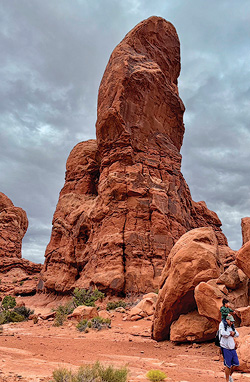 View from the south
View from the south
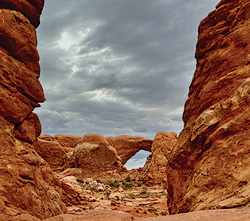 Looking east to the South Window Arch
Looking east to the South Window Arch
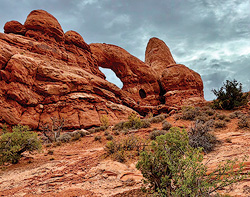 North face of Turret
North face of Turret
-sharpened.jpg) Kathy Grossman Kathy Grossman draws, hikes, reads, writes, and gardens in a house between Mill and Pack Creeks. She moved to Moab in 2011 for the slick rock and the library.
|




-sharpened.jpg) Kathy Grossman draws, hikes, reads, writes, and gardens in a house between Mill and Pack Creeks. She moved to Moab in 2011 for the slick rock and the library.
Kathy Grossman draws, hikes, reads, writes, and gardens in a house between Mill and Pack Creeks. She moved to Moab in 2011 for the slick rock and the library.